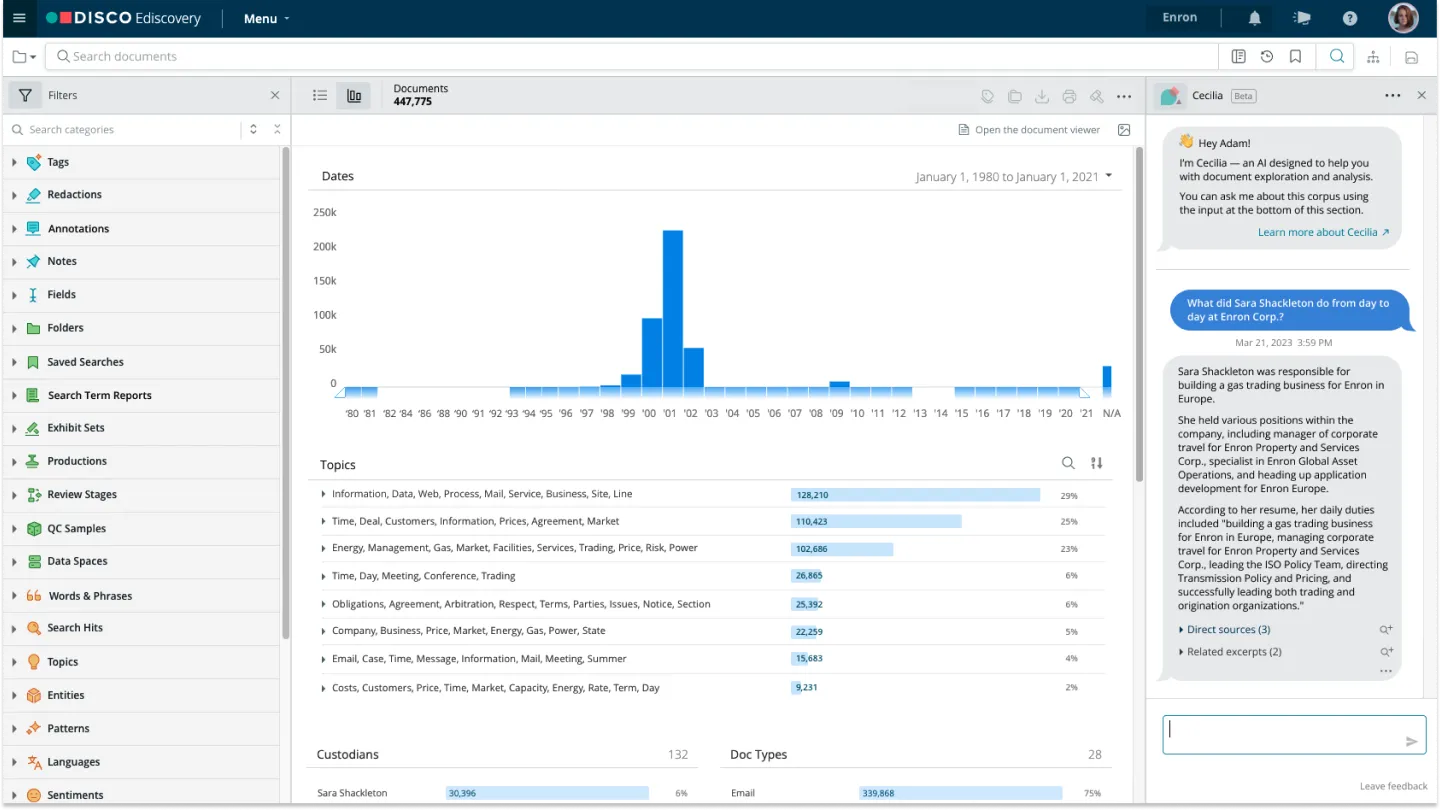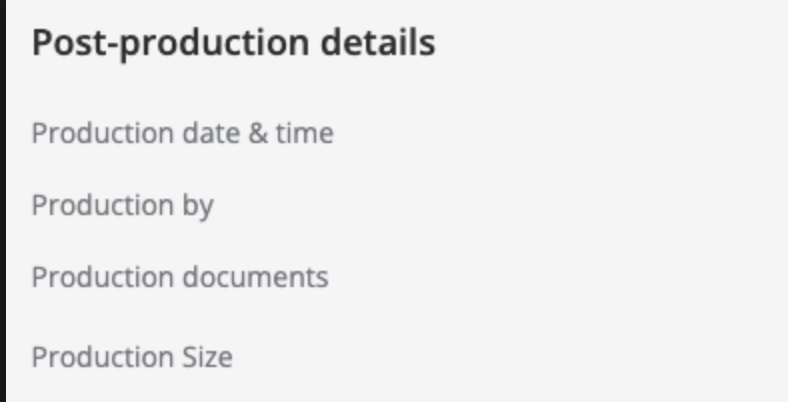⚡️ 1-Minute DISCO Download
Bates numbering isn't dead – but using PDF tools for Bates stamping is a critical mistake. This method strips essential metadata, lacks audit trails, and fails at scale, creating productions that are inefficient, and costly in modern ediscovery.
📊 Key Quote: “Converting native files to PDFs, stripping out metadata, and layering on numbers may look like compliance, but it actually introduces errors, inefficiency, and productions that don’t stand up to scrutiny.”
🌊 Dive Deeper: Check out "10 Ways PDF Tools Fail at Bates Numbering – And Expose You to Risk." It details the top reasons — from metadata loss to incomplete redactions — that using PDF software can jeopardize your case.
For more than a century, Bates numbers have been the backbone of litigation productions — from mechanical stamps on paper files to digital numbering in PDFs and ediscovery platforms. They’re still a fixture in discovery, but their role is changing.
Popular, widely available PDF software has made Bates stamping cheap and accessible, which is why so many firms still rely on it. But these tools were never built for discovery. Converting native files to PDFs, stripping out metadata, and layering on numbers may look like compliance – but it actually introduces errors, inefficiency, and productions that don’t stand up to scrutiny.
This is the paradox of modern discovery: Bates numbers aren’t dead, but PDF software’s way of applying them is. In this article, I’ll unpack why — from metadata loss to missing audit trails — and show how to handle Bates numbers the way litigation demands.
What is Bates numbering?
Bates numbering, or Bates stamping, is a system for assigning unique, sequential identifiers to pages in a collection of documents. It ensures that every page can be referenced, cited, and retrieved quickly.
By providing consistency across large document sets, Bates numbers make it easier for legal teams and opposing parties to stay organized, avoid confusion, and maintain a clear record of evidence in litigation.
How is Bates numbering done?
Bates numbering is performed with software that has this functionality, most often dedicated ediscovery platforms or general-purpose PDF tools. The number is stamped in document headers or footers, often with customizable prefixes or suffixes to identify the matter.
For teams without ediscovery tools, PDF software has become the de facto solution. It’s inexpensive, widely available, and easy to run across batches of PDFs. But that popularity has less to do with legal defensibility than with cost and convenience.
8 Ways PDF Tools Fail at Bates Numbering – And Expose You to Risk
Despite its popularity, PDF software was never designed for the demands of ediscovery. Its Bates numbering feature may look like a quick, low-cost solution, but it introduces risks and inefficiencies that no serious ediscovery team can afford. Here’s what you need to know.
- Lack of ediscovery functionality and compliance
These programs were built for PDFs, not for discovery productions. Their Bates numbering tools add text overlays to image files, confusing downstream systems that may skip Optical Character Recognition (“OCR’) or misread the file entirely. Beyond that, many PDF tools cannot preserve original metadata, generate load files,* or integrate into secure, centralized review platforms.
The result: incomplete or flawed processing before review even begins.
*In ediscovery, a load file is a specially structured file (such as .dat or .csv) that contains information about ESI in a matter, such as document names, text, and metadata. It serves as an index or map, connecting files for organized searching and viewing in ediscovery software, and helping the receiving party import, organize, and understand the information.
- Metadata loss issues expose firms to unnecessary risk
Applying Bates numbers in most PDF software requires teams to convert native files — Word documents, spreadsheets, emails — into PDFs. That step alone can wipe out valuable metadata like author, creation date, or last modified date, which often serve as critical evidence in discovery.
This can also eliminate valuable metadata for emails, damaging any chance of email threading or ensuring attachments are kept with the email. For text messages, Slack, or MS Teams messages, modern attachments will not be included either. This requires hours of manual work, and harms the integrity of your collection.
- Limited search functionality slows review
The loss of metadata creates a massive downstream problem: an inefficient and painfully slow document review. Once native files are converted into static PDFs, they become a digital version of a paper pile, and review becomes limited to what PDF software can handle — basic keyword or phrase searching. This forces legal teams to hunt for evidence with one hand tied behind their back.
Without metadata, you can't run strategic searches like "show me all emails sent by the CFO in December" or "filter for all spreadsheets created before the litigation hold." Instead, reviewers are forced to manually sift through thousands of documents that a proper ediscovery platform would have culled in seconds, dramatically increasing review time, costs, and the risk of missing evidence.
- Scalability limitations can lead to crashes
Today, ediscovery involves a wide range of platforms and document types, and hundreds of thousands of pages, adding up to terabytes of data. PDF programs simply can’t keep up.
By contrast, ediscovery platforms are designed to handle millions of documents at once, distributing the workload across servers and keeping review teams moving. Popular PDF tools may work for small matters, but the scale of modern litigation presents serious challenges.
- Branding inconsistencies and errors undermine credibility
Productions need to be branded consistently — with the Bates numbers and Privilege/Confidential branding across every document. PDF tools make that harder than it should be.
Each production requires manual setup, which opens the door to human error and inconsistent results. If the PDF software you’ve chosen has no built-in quality control to confirm numbering is complete or to catch skipped ranges and duplicates, it can be challenging to confirm that redactions have been applied correctly.
The result? Productions that risk missing numbers, overlapping sequences, and branding errors that can undermine credibility with the court or opposing counsel.
- Lack of audit trails hurts defensibility
When you “brand” documents in some PDF programs, there’s no record of who applied the Bates numbers – nor when or how. That might not matter for internal use, but in litigation it leaves a glaring hole.
Courts and opposing counsel often ask for proof of how a production was created. Without an audit trail, you can’t demonstrate consistency or accuracy, and your production can be called into question. What feels like a simple shortcut can turn into hours of rework — or worse, disputes you can’t easily defend.
By contrast, ediscovery platforms generate step-by-step audit trails that document every action taken. That level of transparency is what courts expect — and without it, productions built in PDF programs simply don’t hold up.
- Inability to handle complex productions
Complex cases rarely involve a single, uniform production. Multi-party matters may require separate sets for different recipients, each with unique confidentiality stamps, privilege redactions, and numbering schemes. Dedicated ediscovery platforms handle these tasks seamlessly, but with PDF tools, legal teams are left piecing together manual workarounds that waste time and increase the likelihood of mistakes.
- Incomplete redactions expose privileged information
Redactions are only as strong as the tool behind them. In PDF programs, they can look correct on the surface but still leave underlying text or metadata intact. Opposing counsel can sometimes “lift” that information from the PDF, exposing material that was meant to stay privileged.
The problem stems from these PDF programs’ inability to fully flatten or remove the hidden layers of content. In high-stakes litigation, one failed redaction can compromise strategy, breach confidentiality, and create unnecessary disputes — risks no team can afford to take.
The (not-so-surprising) benefits of using the right tools for Bates stamping
If using free or low-cost tools proves anything, it’s that cutting corners on discovery comes at a cost.
Purpose-built ediscovery platforms eliminate those risks by offering workflows designed for litigation from the ground up. They preserve metadata, generate audit trails, and manage productions at scale — all while giving review teams the speed and confidence they need.
The difference isn’t subtle: with the right tools, discovery is faster, cleaner, and defensible. Here are four core benefits that PDF tools can’t match, but modern platforms deliver every time.
Robust search and filtering options surface the right evidence quickly
Modern ediscovery platforms transform documents into evidence that review teams can work with immediately. Robust search and filtering tools let teams zero in on the right evidence quickly, whether it’s by keyword, custodian, date range, or metadata field.
Load file generation prevents re-productions and wasted hours
Productions today are expected to include industry-standard load files — the DATs and OPTs that map text, metadata, and native links into review platforms. PDF programs can’t create them. Dedicated ediscovery platforms handle this automatically, helping to enable productions that are properly formatted and ready for opposing counsel.
Having this capability built in avoids costly disputes, re-productions, and wasted hours stitching together files by hand. For litigation teams, reliable load file generation is not a “nice to have.” It’s a baseline requirement.
Collaborative workflows facilitate discovery
Discovery is a team sport. Attorneys, litigation support, and review managers all need access to the same documents, in real time, with a clear record of who did what.
Ediscovery platforms are built for collaboration. They provide role-based permissions, and audit trails so every step is transparent and defensible. Teams can search, review, redact, and produce from a single system. The result is fewer errors, smoother communication, and a workflow that keeps cases moving forward.
Scalability and reliability are critical
The true test of any discovery tool is scale. A small set of documents is one thing; millions of files across custodians, formats, and jurisdictions is another. Ediscovery platforms like DISCO are built to handle this kind of volume.
DISCO processes large datasets without crashing and has the speed and stability needed for high-stakes matters. Whether the case involves a few gigabytes or multiple terabytes, it scales seamlessly so legal teams can stay focused on strategy. That reliability is what makes DISCO indispensable in modern litigation.
How DISCO handles Bates numbers
Modern litigation doesn’t eliminate the need for Bates numbers — it redefines their role. DISCO automates the process as part of its export workflow, applying numbers consistently across productions without stripping metadata or breaking audit trails.
Instead of overlaying text onto static PDFs, DISCO preserves the integrity of native files while still delivering Bates-stamped versions for production.
Because everything happens inside a centralized, secure platform, teams avoid the pitfalls of juggling multiple storage locations or redoing work when errors occur. The result is numbering that’s fast, consistent, and enables a defensible process — exactly what courts and clients expect.
Are Bates numbers dead?
Strictly speaking, no. Bates numbers still appear in almost every production. But their role has changed. Once the backbone of discovery, they’re now little more than an overlay. True defensibility today comes from preserving metadata, generating standardized load files, maintaining audit trails, and managing productions at scale.
That’s why PDF software — which reduce Bates numbering to a cosmetic stamp on a PDF — fall short. They reflect a paper-era mindset in a digital world. In modern litigation, the future belongs to platforms built for ediscovery.
Ready to move beyond Bates numbers?
- See DISCO in action: Request a demo and discover how DISCO automates Bates numbering as part of a fully defensible workflow.
- Dig deeper: Get the guide to in-house ediscovery, including cutting edge tactics and strategies for more efficient and accurate ediscovery.
- Talk to an expert: Connect with DISCO’s Managed Review team to ensure your next production is accurate, efficient, and defensible.






%20(1).jpeg)








%20(1).jpg)